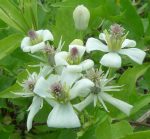
Also known by many other names including peppervine, old man’s beard, and creek clematis, this climbing woody or semi-woody vine is native to western US where it grows in streamside thickets, wooded hillsides, forests edges and sagebush deserts. It is a member of buttercup family, Ranunculaceae, that also includes columbine, delphinium, and hellebore. Plants grow 20′ or more and have pinnately compound leaves with 5 thick, coarsely toothed leaflets that turn yellow in the fall. In summer, clusters of tiny white male and female flowers appear in the upper leaf axils on different plants. The flowers are fragrant, lack petals but have 4 showy sepals, and give way to silky feathery fruits that resemble an old man’s beard. Plants are drought tolerant and a good choice for erosion control. The genus name, Clematis, is the ancient Greek word klematis referring to a climbing plant. The specific epithet, ligusticifolia, comes from the Latin words ligustrum meaning privet, and folia meaning leaf, and refers to the resemblance of the leaf to that of privet.
Type: Woody or semi-woody vine
Bloom: Tiny white male and female flowers on different plants in summer
Size: 20′ and more
Light: Full sun or partial shade
Soil: Fertile, dry to medium moist, well-drained
Hardiness: Zones 4-10
Care: Mulch to keep the roots cool in summer; prune in early spring, overgrown plants can be pruned to within a few inches of the ground; provide a strong support.
Pests and Diseases: Leaf spot, clematis wilt, powdery mildew, rust
Propagation: Cutting, layering, seed
Photo Credit: Wikipedia
`